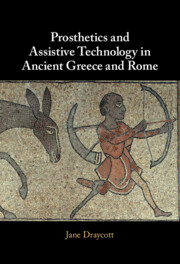26 results
Chapter 2 - Automata, Cyborgs, and Hybrids
- from Part I - Blended Bodies
-
-
- Book:
- Body and Machine in Classical Antiquity
- Published online:
- 13 July 2023
- Print publication:
- 27 July 2023, pp 48-69
-
- Chapter
- Export citation
Chapter 4 - Design, Commission, and Manufacture of Prostheses
-
- Book:
- Prosthetics and Assistive Technology in Ancient Greece and Rome
- Published online:
- 08 December 2022
- Print publication:
- 22 December 2022, pp 124-153
-
- Chapter
- Export citation
Introduction
-
- Book:
- Prosthetics and Assistive Technology in Ancient Greece and Rome
- Published online:
- 08 December 2022
- Print publication:
- 22 December 2022, pp 1-39
-
- Chapter
- Export citation
Chapter 5 - Living Prostheses
-
- Book:
- Prosthetics and Assistive Technology in Ancient Greece and Rome
- Published online:
- 08 December 2022
- Print publication:
- 22 December 2022, pp 154-168
-
- Chapter
- Export citation
References
-
- Book:
- Prosthetics and Assistive Technology in Ancient Greece and Rome
- Published online:
- 08 December 2022
- Print publication:
- 22 December 2022, pp 176-194
-
- Chapter
- Export citation
Index Locorum
-
- Book:
- Prosthetics and Assistive Technology in Ancient Greece and Rome
- Published online:
- 08 December 2022
- Print publication:
- 22 December 2022, pp 195-199
-
- Chapter
- Export citation
Copyright page
-
- Book:
- Prosthetics and Assistive Technology in Ancient Greece and Rome
- Published online:
- 08 December 2022
- Print publication:
- 22 December 2022, pp iv-iv
-
- Chapter
- Export citation
Tables
-
- Book:
- Prosthetics and Assistive Technology in Ancient Greece and Rome
- Published online:
- 08 December 2022
- Print publication:
- 22 December 2022, pp x-x
-
- Chapter
- Export citation
Conclusion
-
- Book:
- Prosthetics and Assistive Technology in Ancient Greece and Rome
- Published online:
- 08 December 2022
- Print publication:
- 22 December 2022, pp 169-175
-
- Chapter
- Export citation
Contents
-
- Book:
- Prosthetics and Assistive Technology in Ancient Greece and Rome
- Published online:
- 08 December 2022
- Print publication:
- 22 December 2022, pp vii-vii
-
- Chapter
- Export citation
Dedication
-
- Book:
- Prosthetics and Assistive Technology in Ancient Greece and Rome
- Published online:
- 08 December 2022
- Print publication:
- 22 December 2022, pp v-vi
-
- Chapter
- Export citation
Chapter 1 - Extremity Prostheses and Assistive Technology
-
- Book:
- Prosthetics and Assistive Technology in Ancient Greece and Rome
- Published online:
- 08 December 2022
- Print publication:
- 22 December 2022, pp 40-72
-
- Chapter
- Export citation
Chapter 3 - Hair Prostheses
-
- Book:
- Prosthetics and Assistive Technology in Ancient Greece and Rome
- Published online:
- 08 December 2022
- Print publication:
- 22 December 2022, pp 102-123
-
- Chapter
- Export citation
Index
-
- Book:
- Prosthetics and Assistive Technology in Ancient Greece and Rome
- Published online:
- 08 December 2022
- Print publication:
- 22 December 2022, pp 200-202
-
- Chapter
- Export citation
Chapter 2 - Facial Prostheses
-
- Book:
- Prosthetics and Assistive Technology in Ancient Greece and Rome
- Published online:
- 08 December 2022
- Print publication:
- 22 December 2022, pp 73-101
-
- Chapter
- Export citation
Abbreviations
-
- Book:
- Prosthetics and Assistive Technology in Ancient Greece and Rome
- Published online:
- 08 December 2022
- Print publication:
- 22 December 2022, pp xiii-xxii
-
- Chapter
- Export citation
Acknowledgements
-
- Book:
- Prosthetics and Assistive Technology in Ancient Greece and Rome
- Published online:
- 08 December 2022
- Print publication:
- 22 December 2022, pp xi-xii
-
- Chapter
- Export citation
Figures
-
- Book:
- Prosthetics and Assistive Technology in Ancient Greece and Rome
- Published online:
- 08 December 2022
- Print publication:
- 22 December 2022, pp viii-ix
-
- Chapter
- Export citation

Prosthetics and Assistive Technology in Ancient Greece and Rome
-
- Published online:
- 08 December 2022
- Print publication:
- 22 December 2022
THE HIPPOCRATIC CORPUS - (P.E.) Pormann (ed.) The Cambridge Companion to Hippocrates. Pp. xx + 441. Cambridge: Cambridge University Press, 2018. Paper, £26.99, US$37.99 (Cased, £75, US$105). ISBN: 978-1-107-69584-9 (978-1-107-06820-9 hbk).
-
- Journal:
- The Classical Review / Volume 70 / Issue 1 / April 2020
- Published online by Cambridge University Press:
- 31 January 2020, pp. 34-36
- Print publication:
- April 2020
-
- Article
- Export citation



